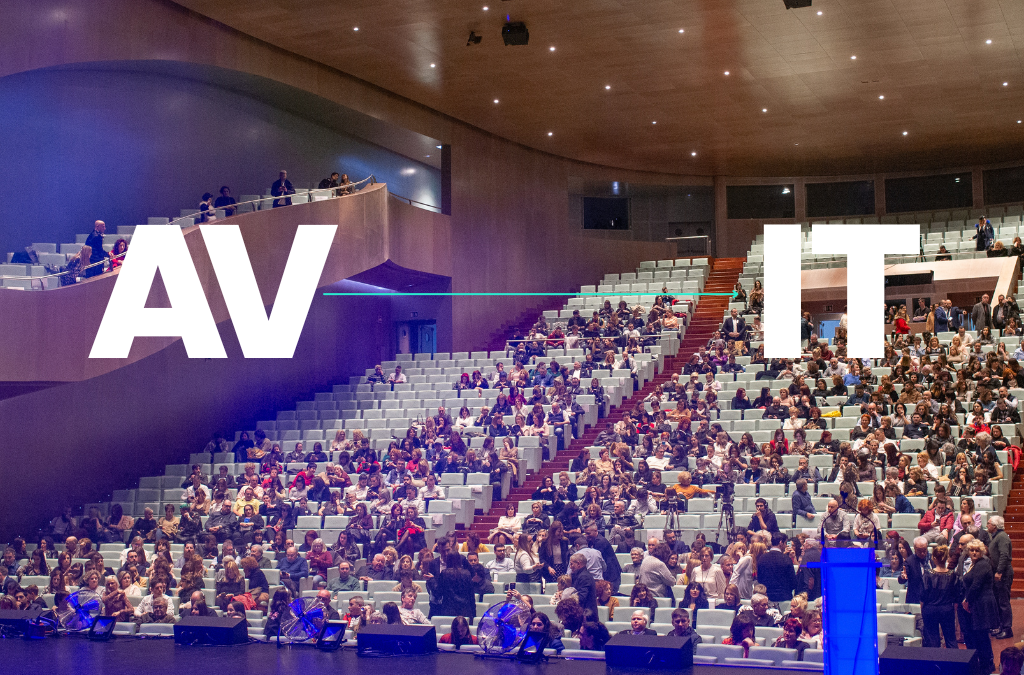“The technology you use impresses no one. The experience you create with it is everything.”
– Sean Gerety
Audiovisual technology (AV) has become central to the experience of the modern age – but this centrality is brand new. AV has always been the “other” department, existing in the peripheral vision of IT professionals.
They think of AV as a different playground—characterised by HDMI cables, projectors, and display screens. For them, AV deals with communication and display rather than computation and data management. AV handles equipment; IT handles the network.
AV and IT have been like oil and water, distinctly separate in the organisational chart and rarely, if ever, mixing.
But that’s changing.
The silent wave: AV/IT convergence
What started as a murmur in IT team break-rooms around the world has now turned into a full-blown revolution that experts have named “AV/IT convergence.”
The lines between AV and IT are blurring – and this has ramifications far beyond IT. This is a seismic shift redefining the architecture of modern business.
“AV can no longer be partitioned off and treated as an afterthought,” says Paul Yahchouchy, founder and CEO of Innomate. “It’s becoming an integral part of how we communicate and operate.”
How the pandemic accelerated the AV/IT convergence
Cast your mind back to the pandemic.
Workers interfacing through just the internet. Kids learning from home. Parents catching up with Grampa through FaceTime.
The internet became a literal lifeline for many of us, especially evident in the healthcare sector’s rapid shift to telehealth. Thanks to AV technology, which was central to this paradigm change, the transition was smoother than expected. Pioneering AV experts had already laid the groundwork, ensuring the foundational infrastructure was in place.
As media scholar Mikos notes, “With the advent of the internet, audiovisual production extended to include all content that could be displayed online.”
The currency of the modern era is information, and that information is transmitted through audiovisual technology and production.
The children of today are “the first generation born with a mouse in their hands and a computer monitor that plays the role of a window to the world for them” (Mikos, 2017).
The importance of this cannot possibly be overstated. The very means by which we interact with the world has become AV technology – for every industry, for every business, for every person.
The new frontiers of AV
Gone are the days when AV was a mere add-on. The new wave of AV solutions are not just interconnected, but are also intelligent.
“Now,” says Paul, “video conferencing systems, digital signage, and interactive whiteboards are intrinsically tied to network connectivity, cloud computing, and data analytics. This is no longer a choice; it’s a requirement for optimal performance.”
As Cindy Davis of AV Technology puts it, we’re in a “supermoon” phase where AV and IT are nearer to each other than ever before.
The age-old dilemma: hardware vs software
AV has traditionally been hardware, while most software has remained the realm of IT. This has led to a problem that most people are frustrated with daily, without even realising: AV hardware sprinted ahead, and software lagged behind.
This dissonance between AV hardware and software has become one of the most relevant challenges of our time. We’ve all struggled with incompatible HDMI cables, varying operating systems, and tangled wires connecting our myriad devices.
Here at Innomate, we see this issue become even more glaring in educational settings.
Universities rely on devices, but have rooms full of devices that can’t speak to each other and have incompatible hardware.
Lecturers spend half the class figuring out how to turn on the projector and turn off their students’ microphones. Then they call the IT department, who don’t have the data at hand to know what the issue is.
The AV window to the world is foggy.
How Innomate bridges AV and IT
Innomate is built from this problem. Our software acts as a linchpin that ties AV hardware into a coherent system, falling under a unified platform. Our solutions not only simplify the lives of end-users but also offer a powerful toolkit for IT professionals.
The metamorphosis of AV from a sideline player to a cornerstone of IT is a phenomenon that most people have missed. But the impact of this shift is undeniable. It’s a game-changer that is quietly – but irrevocably – rewriting the rules of technological engagement.
The world may have been slow to notice this transformation, but as its profound impacts continue to unfold, sidelining AV is no longer an option – you may as well sideline the internet itself.
Do you want to manage your AV like it’s IT?


